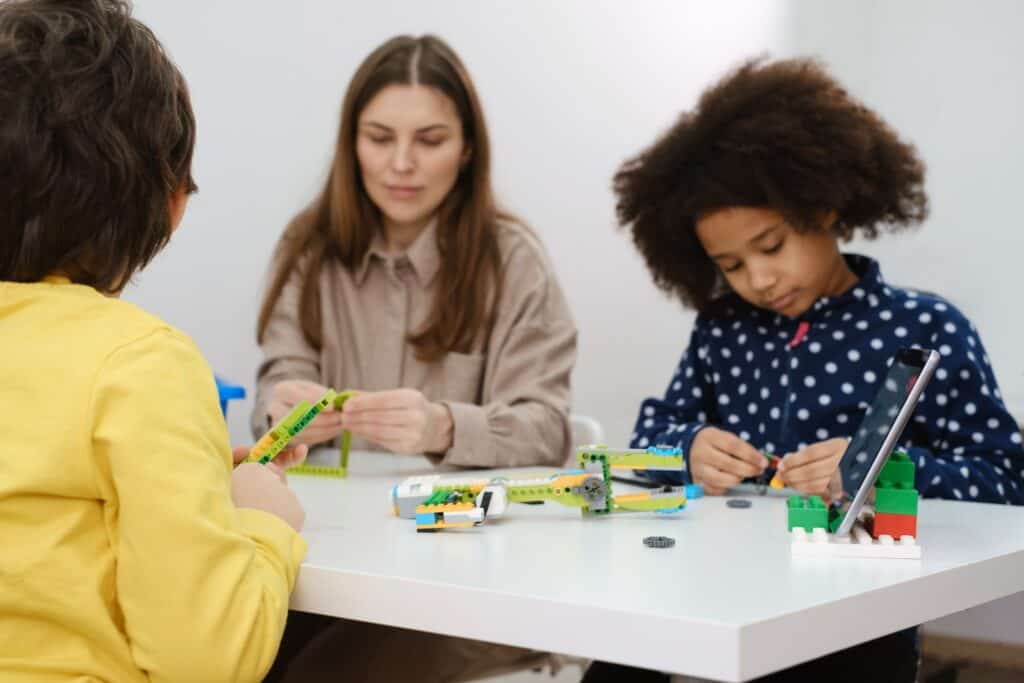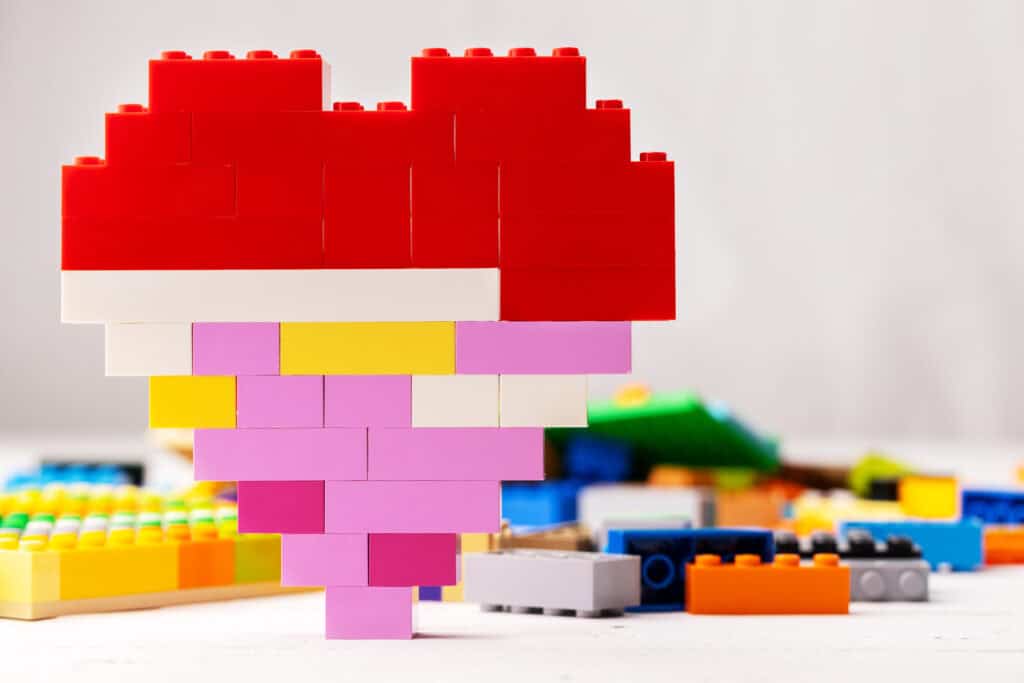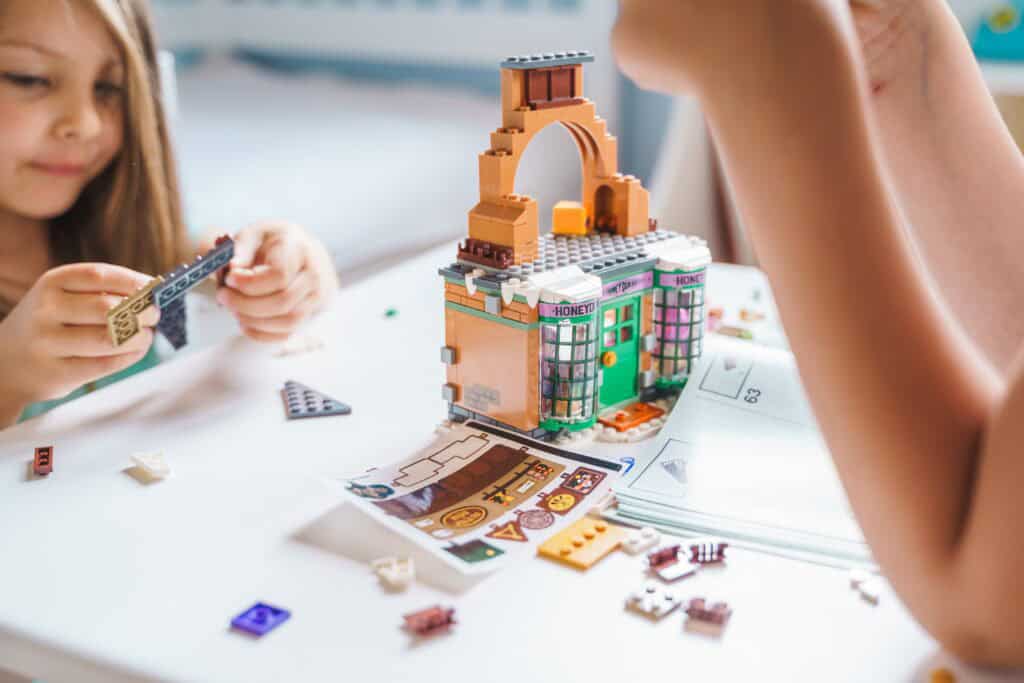Seeing LEGO®bricks scattered out across your living room floor might feel like just another mess to clean up.
What if those tiny pieces were more than just clutter?
What if they could help your child grow in ways you never imagined?
Play is a universal way for kids to explore, learn, and express themselves—whether they are neurodivergent or neurotypical. The right toys can do more than entertain; they foster essential life skills. For many, LEGO® sets are powerful tools for creativity, problem-solving, and social growth.
Neuroscience Insight
Research indicates that LEGO® Therapy activates neural pathways associated with social cognition and executive functioning, particularly in children with Autism Spectrum Disorder. This activation allows LEGO® play to improve communication skills, help children process social cues, and promote teamwork in a structured, supportive environment.
How LEGO® Therapy Increases Social Cognition in Neurodivergent Children
LEGO® is more than just colourful building blocks – they are gateways to endless possibilities for children. These multifaceted pieces transform into speedy race cars, busy cityscapes, or beautiful bouquets. LEGO® sets can even turn into Polaroid cameras and puppies. They invite us into stories we create, sparking joy and adventure with every brick.
These tiny bricks have the power to foster many meaningful skills in children – problem-solving abilities, creativity, and social skills.
Neurodivergent children face unique challenges when it comes to social interaction, communication, and emotional regulation. These difficulties can create barriers for neurodiverse children to connect with peers, siblings, and family members. LEGO® play offers a structured and accessible way to express emotions and engage with the outside world. Through LEGO® children can share ideas, better collaborate with those around them, and build connections in a safe environment LEGO® bricks may be the key to help bridge the gaps in social connection and emotional regulation.

10 Benefits of LEGO® Therapy for Neurodivergent Children:
- Constructing LEGO® sets can be a calming activity that helps children develop patience and resilience.
- Collaborative building fosters conversations, sharing ideas, and teamwork among peers.
- Figuring out how to complete a design or rebuild mistakes sharpens problem-solving skills.
- From imaginative free builds to intricate sets, LEGO® inspires children to think outside the box.
- Manipulating small pieces improves fine motor skills and spatial awareness.
- Group LEGO® play builds trust, cooperation, and positive relationships.
- Completing a LEGO® set gives children a sense of accomplishment and pride.
- Waiting for a turn during group play strengthens self-control and cooperation.
- Children can use LEGO® to visually represent their emotions and ideas.
- Role-playing with LEGO® scenes (like a bus stop or grocery store) helps children practice navigating everyday situations.
PAUSE AND REFLECT
Think about your last LEGO® play session with your child.
How could you use this time to strengthen their communication or problem-solving skills?
Could you involve siblings or friends to create a collaborative activity?
Practical Steps Use LEGOS® for Social Growth:
- Create a structured environment such as a designated play area with clear rules and goals. Use visual aids or instructions to guide the activity.
- Encourage collaborative building by involving others where each person has a role in the group play.
- LEGO therapy targets areas of functioning for children with autism that need increased attention, such as a lack of flexibility in the division of roles. The therapy is constructed in such a way that each child participating in it has a chance to be a different character, such as a builder, helper, creator, master, genius. Thanks to this, children develop their various competences, including leadership.
- Create opportunities to build emotional skills such as teaching patience through turn-taking, strengthening frustration tolerance by rebuilding mistakes, and navigating challenges by finding missing pieces.
- Initiate emotional expression by asking your child to construct the LEGOS® in a way that reflects their feelings towards various situations or people.
- Incorporate real-life scenarios such as a grocery store or bus stop to practice and prepare for different situations.
- Integrate discussion time to discuss what worked well and what didn’t during the activity, and to generate future ideas. This can also foster connection and trust, further strengthening bonds.
- Most importantly – celebrate the creative process and child’s involvement in creative creation to help build confidence and a sense of achievement. This will create a positive feedback loop between your child and LEGO® play.
Allowing different family members and peers to participate in the creation of the LEGO® builds fosters collaboration and helps the child feel proud of creating something together. This shared activity can promote healthy relationships and strengthen current bonds. LEGO® play can help conquer feelings of isolation or misunderstanding.

LEGO® play allows for …
- Shared moments that build connections and teamwork between family members and friends, as well as making all members feel included.
- Building structures that support spatial awareness for children.
- Manipulating the pieces which improve hand-eye coordination.
- Constructing and arranging LEGO sets which boosts creativity and improves problem-solving skills.
- Assembling LEGOs can improve self-confidence and be a calming activity that aids in emotional regulation.
- For children with autism, it helps to strengthen the maintenance of eye contact.
Neurodiverse children may encounter different obstacles from neurotypical peers, but they can still thrive together and apart. LEGO® play has become a positive and efficient way to foster important social skills, encourage emotional regulation, and strengthen relationships. The colourful bricks can nurture many skills that will be essential in everyday life. Children can learn to better express their feelings, experience and explore teamwork, and celebrate differences. In a world with much diversity, building connections and skills creates a foundation for growth and understanding. While building and beyond, every creation tells a unique story that is worth assembling. e strengthened through awareness, curiosity, and intentional practice.
Cultural Connection
In Native American cultures, storytelling through art is a tool that promotes individual expression and connection with others. LEGO® play, like storytelling, can be a way for neurodivergent children to express themselves, enrich their creativity, and build meaningful relationships with those they interact with.

Free Resources & Companion Reads for Neurodivergent Creativity Through Play
LEGO® therapy is about building confidence, communication, and community. To help you get the most out of your play sessions, we’ve curated a set of free, science-aligned tools designed to support neurodivergent development through creativity, movement, and relational learning.
Free Tools You Can Use Today
- 8 Senses Scavenger Hunt
A movement-rich activity that engages sensory awareness and spatial intelligence—perfect for pairing with LEGO®-inspired challenges. - Friendship Recipe Cards
Designed for playful social learning, these printable cards offer scenarios and prompts that pair beautifully with LEGO® scene-building to practise empathy, turn-taking, and teamwork. - Play Ideas from Around the World
Expand your LEGO® time into a global play journey with culturally-inspired games and building prompts that celebrate diversity. - Incorporating Music into Daily Activities
Bring rhythm into your builds! This guide integrates music and LEGO® time for increased focus, sensory regulation, and creativity.
All resources are free to our subscribers. Sign up here to download, print, and start using them right away to support inclusive, joyful learning.

Articles That Pair Well with LEGO®-Based Therapy
- How Music and Movement Support Neurodivergent Individuals – Explore how combining rhythm with LEGO® play can support attention, memory, and social bonding.
- Empathy Milestones: How Empathy Develops from Infancy to Adolescence – Understand how storytelling can scaffold empathy-building at every stage of child development.
- Understanding Challenging Behaviours in Children – Explore emotional triggers, improve communication, and model problem-solving in safe, creative ways.
- Embracing Imperfection and Self-Acceptance – Learn how embrace a growth mindset, resilience, and joyful imperfection.
By integrating these tools and articles into your LEGO® sessions, you can create not just engaging play—but lasting change.
Final Thoughts
Next time you see LEGO® pieces scattered across the room, think of them as a tool for growth. Embrace the mess and celebrate progress, one brick at a time. LEGO® play nurtures creativity, builds connections, and tells unique stories that inspire understanding and growth.

Reflect
Have LEGO® sets made a difference for your child?
Reflect and pass this piece along to other parents looking for ways to foster growth through play.
References:
Hodge, F. S., Pasqua, A., Marquez, C. A., & Geishirt-Cantrell, B. (2002). Utilizing traditional storytelling to promote wellness in American Indian communities. Journal of Transcultural Nursing, 13(1), 6–11. https://doi.org/10.1177/104365960201300102
- Huskens, B., Palmen, A., Van der Werff, M., et al. (2015). Improving collaborative play between children with autism spectrum disorders and their siblings: The effectiveness of a robot-mediated intervention based on LEGO® therapy. Journal of Autism and Developmental Disorders, 45, 3746–3755. https://doi.org/10.1007/s10803-014-2326-0
- Levy, J., & Dunsmuir, S. (2020). Lego Therapy: Building social skills for adolescents with an Autism Spectrum Disorder. Educational and Child Psychology, 37(1), 58–83. https://doi.org/10.53841/bpsecp.2020.37.1.58
- Lindsay, S., Hounsell, K. G., & Cassiani, C. (2017). A scoping review of the role of LEGO® therapy for improving inclusion and social skills among children and youth with autism. Disability and Health Journal, 10(2), 173–182. https://doi.org/10.1016/j.dhjo.2016.10.010
- Narzisi, A., Sesso, G., Berloffa, S., Fantozzi, P., Muccio, R., Valente, E., Viglione, V., Villafranca, A., Milone, A., & Masi, G. (2021). Could you give me the blue brick? LEGO®-based therapy as a social development program for children with Autism Spectrum Disorder: A systematic review. Brainsci, 11(6), 702. https://doi.org/10.3390/brainsci11060702
- Vegni, N., D’Ardia, C., Di Filippo, G., & Melchiori, F. M. (2023). The impact of Lego® Therapy on cognitive skills in Autism Spectrum Disorders: a brief discussion. AIMS neuroscience, 10(2), 190–199. https://doi.org/10.3934/Neuroscience.2023016
- LEGO-Based therapy. (2014, June 21). Blackwell’s. https://blackwells.co.uk/bookshop/product/LEGO-Based-Therapy-by-Daniel-B-LeGoff-Gina-Gmez-De-La-Cuesta-G-W-Krauss-Simon-Baron-Cohen/9781849055376
This piece was written for you by
A cognitive science student at the University of Virginia / Neuro Brain Trust Member
Jessica is a cognitive science student at the University of Virginia and a research assistant at the Developmental Neuroanalytics Lab. Passionate about neuroscience and science communication, she explores human development through research and writing.
